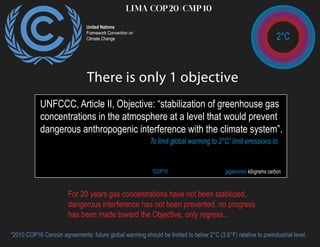1. The document discusses limiting global warming to 2 degrees Celsius as agreed upon in 2010.
2. It notes that to achieve this, all anthropogenic emissions from 2013 to 2100 must be limited to 260 gigatonnes of carbon.
3. At current emission trends, 247 additional gigatonnes of carbon will be emitted in just 21 years, far exceeding the 2 degree limit. Urgent action is needed to reduce emissions.






















































































